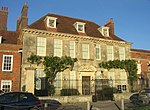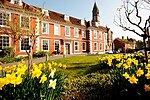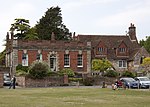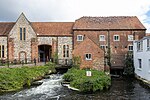Salisbury Playhouse
Buildings and structures in SalisburyProducing theatres in EnglandTheatres completed in 1976Theatres in Wiltshire

Salisbury Playhouse is a theatre in the English city of Salisbury, Wiltshire. Built in 1976, it comprises the 517-seat Main House and the 149-seat Salberg Studio, a rehearsal room, a daytime café, and a community and education space. It is part of Arts Council England's National Portfolio of Organisations, and also receives regular funding from Wiltshire Council and Salisbury City Council.
Excerpt from the Wikipedia article Salisbury Playhouse (License: CC BY-SA 3.0, Authors, Images).Salisbury Playhouse
High Street, Salisbury Harnham
Geographical coordinates (GPS) Address Website Nearby Places Show on map
Geographical coordinates (GPS)
| Latitude | Longitude |
|---|---|
| N 51.067 ° | E -1.798 ° |
Address
Brian Leonard
High Street 64
SP1 2PD Salisbury, Harnham
England, United Kingdom
Open on Google Maps










